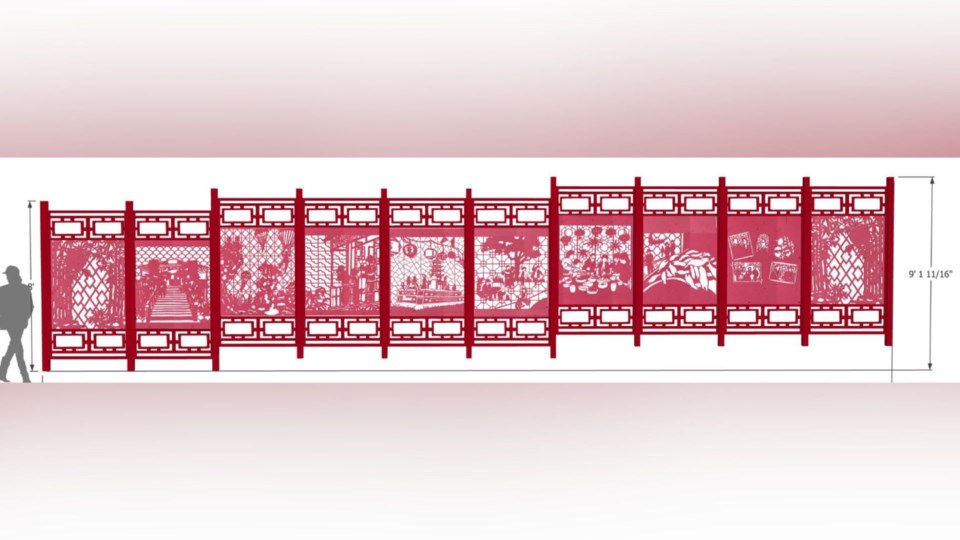A public art installation in downtown New West is part of the city’s efforts to recognize the Chinese Canadian community.
The City of New Westminster has commissioned artist Karen Tam to create public art for a new park at 824 Agnes St. Located on the former site of the Chinese Benevolent Association of New Westminster, the Agnes Street Commemorative Park will honour and celebrate New Westminster’s Chinese Canadian community.
"The City of New Westminster recognizes the significant role of early Chinese settlers in the development of our city. There is evidence of at least two former Chinatowns in New Westminster, one in the area of Agnes and Eighth streets,” said Mayor Patrick Johnstone. “We’re grateful for the opportunity Tam’s engaging artwork will provide for park visitors to reflect on the lives and stories of our early Chinese settlers.”
According to a news release from the city, a selection panel chose Tam’s concept proposal for the commission in 2023.
“Tam drew inspiration from archival photographs and documents; her artwork, Grove of Wild Bamboo and Sweet Peas, was selected for its powerful response to the site's history and Chinese community,” said the news release. “Made up of a series of panels reminiscent of traditional Chinese hand-scroll paintings, paper-cutting and latticework, the artwork will weave a visual narrative that connects the past, present, and future.”
Funding for the park's construction is being provided by Brookfield Properties as a community amenity contribution for its residential tower redevelopment at 810 Agnes St. Construction is set to begin in 2026, and the park is expected to be completed in fall of 2027.
Karen Tam 譚嘉文 , an award-winning artist and curator from Tiohtià:ke/Montréal, has exhibited her work in North America, Europe, and China.
“My approach to public art is always about creating connections — between site and context, artist and community — so that the work becomes a reflection of shared histories and lived experiences,” she said in the news release. “As I delved into the history of the Chinese community in New Westminster, I was struck by the depth of contributions made by these early Chinese Canadian families. Their resilience and ability to create community despite systemic barriers inspired me.”
Tam said this project is both a celebration and a tribute.
“And as my first permanent public artwork, it marks a significant milestone in my career,” she said. “I am deeply honoured and grateful to have been selected for this opportunity to engage with history in a public space.”
According to the City of New Westminster, the Chinese reconciliation process was initiated by the Canadians for Reconciliation Society in 2009 and culminated in 10 actions promised by council in 2010. In addition to the artwork, the future downtown park will also feature interpretive displays and narratives to recognize and commemorate the Chinese history in New Westminster.
“I am delighted that another one of the 10 redemptive actions the City of New Westminster promised in response to its past historical wrongs toward the Chinese community is close to fruition,” said Bill Chu, founder of the Canadians for Reconciliation Society. “May we treasure this public space and art not just as an opportunity to beautify and humanize the concrete jungle, but to add a needed punctuation in the continuum of time we find ourselves in, a reminder to stop humanity from making the same mistakes to our neighbours, and a GPS to re-orientate our sense of place, shared identity, and community.”
Chinese reconciliation
The use of the downtown site for a commemorative park was endorsed by city council in 2016 in support of reconciliation efforts with the Chinese community, related to past discriminatory practices by local government.
In September 2010, the City of New Westminster became the first municipality in Canada to formally apologize for its discriminatory actions toward Chinese Canadians in past eras.
"The City of New Westminster formally apologizes to the Chinese community for its past actions which resulted in discrimination and exclusion, and it looks forward to working together in the spirit of friendship, community and cooperation to build strong bonds and lasting relations," said the apology that was read out at a council meeting.
Eight months of research by city staff confirmed city council had acted in a discriminatory matter in the late 19th and early 20th centuries. Its actions included restricting employment opportunities and asking senior governments to pass discriminatory laws.
"The City of New Westminster acknowledges, based on a review of city records covering the period from 1860 to 1926, that it acted in a discriminatory manner towards its Chinese community," said the apology. "The City of New Westminster acknowledges that the Chinese community played and continues to play an essential role in the development, growth and prosperity of New Westminster. Currently, about 4,300 people of Chinese ancestry call New Westminster their home."
In February 2011, council supported a motion to repeal all of the bylaws identified in the research that were found to be discriminatory toward Chinese Canadians. Staff’s research found the city discriminated against the Chinese community regarding land and buildings, city regulations, employment opportunities and other areas.

